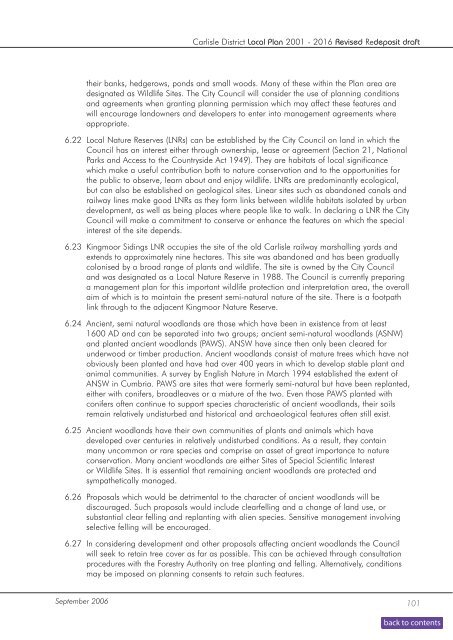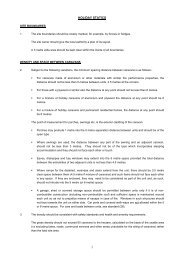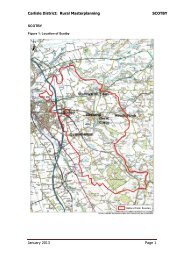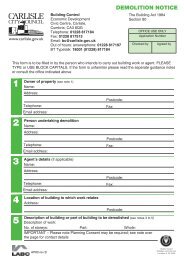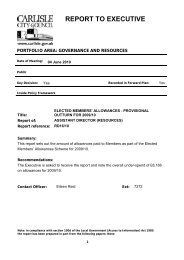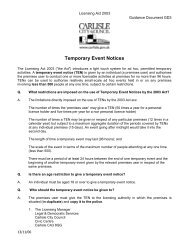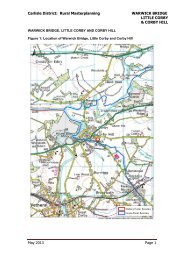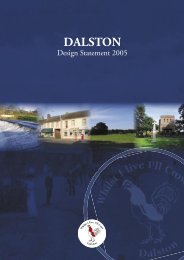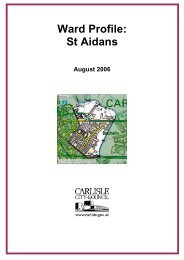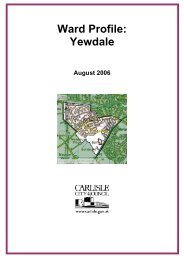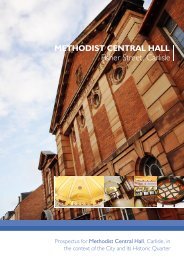Carlisle District Local Plan.indd - Carlisle City Council
Carlisle District Local Plan.indd - Carlisle City Council
Carlisle District Local Plan.indd - Carlisle City Council
Create successful ePaper yourself
Turn your PDF publications into a flip-book with our unique Google optimized e-Paper software.
<strong>Carlisle</strong> <strong>District</strong> <strong>Local</strong> <strong>Plan</strong> 2001 - 2016 Revised Redeposit drafttheir banks, hedgerows, ponds and small woods. Many of these within the <strong>Plan</strong> area aredesignated as Wildlife Sites. The <strong>City</strong> <strong>Council</strong> will consider the use of planning conditionsand agreements when granting planning permission which may affect these features andwill encourage landowners and developers to enter into management agreements whereappropriate.6.22 <strong>Local</strong> Nature Reserves (LNRs) can be established by the <strong>City</strong> <strong>Council</strong> on land in which the<strong>Council</strong> has an interest either through ownership, lease or agreement (Section 21, NationalParks and Access to the Countryside Act 1949). They are habitats of local significancewhich make a useful contribution both to nature conservation and to the opportunities forthe public to observe, learn about and enjoy wildlife. LNRs are predominantly ecological,but can also be established on geological sites. Linear sites such as abandoned canals andrailway lines make good LNRs as they form links between wildlife habitats isolated by urbandevelopment, as well as being places where people like to walk. In declaring a LNR the <strong>City</strong><strong>Council</strong> will make a commitment to conserve or enhance the features on which the specialinterest of the site depends.6.23 Kingmoor Sidings LNR occupies the site of the old <strong>Carlisle</strong> railway marshalling yards andextends to approximately nine hectares. This site was abandoned and has been graduallycolonised by a broad range of plants and wildlife. The site is owned by the <strong>City</strong> <strong>Council</strong>and was designated as a <strong>Local</strong> Nature Reserve in 1988. The <strong>Council</strong> is currently preparinga management plan for this important wildlife protection and interpretation area, the overallaim of which is to maintain the present semi-natural nature of the site. There is a footpathlink through to the adjacent Kingmoor Nature Reserve.6.24 Ancient, semi natural woodlands are those which have been in existence from at least1600 AD and can be separated into two groups; ancient semi-natural woodlands (ASNW)and planted ancient woodlands (PAWS). ANSW have since then only been cleared forunderwood or timber production. Ancient woodlands consist of mature trees which have notobviously been planted and have had over 400 years in which to develop stable plant andanimal communities. A survey by English Nature in March 1994 established the extent ofANSW in Cumbria. PAWS are sites that were formerly semi-natural but have been replanted,either with conifers, broadleaves or a mixture of the two. Even those PAWS planted withconifers often continue to support species characteristic of ancient woodlands, their soilsremain relatively undisturbed and historical and archaeological features often still exist.6.25 Ancient woodlands have their own communities of plants and animals which havedeveloped over centuries in relatively undisturbed conditions. As a result, they containmany uncommon or rare species and comprise an asset of great importance to natureconservation. Many ancient woodlands are either Sites of Special Scientific Interestor Wildlife Sites. It is essential that remaining ancient woodlands are protected andsympathetically managed.6.26 Proposals which would be detrimental to the character of ancient woodlands will bediscouraged. Such proposals would include clearfelling and a change of land use, orsubstantial clear felling and replanting with alien species. Sensitive management involvingselective felling will be encouraged.6.27 In considering development and other proposals affecting ancient woodlands the <strong>Council</strong>will seek to retain tree cover as far as possible. This can be achieved through consultationprocedures with the Forestry Authority on tree planting and felling. Alternatively, conditionsmay be imposed on planning consents to retain such features.September 2006 101


